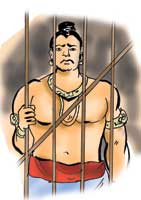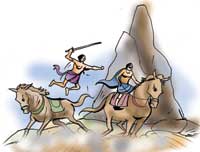1. In South India too, we could observe the same type of political unrest, that prevailed in Sri Lanka, at this time.
The exact years somehow would have differed a
little. Some believe that these occurrences would have been connected in some way. Sundara Pandya, got his father, Kulasekera killed. Thereafter, there was fighting between Sundara Pandya and Veera Pandya, for a long period.
2. In the meantime, the Muslim commander Malik Kapoor, who came from the North, spread his power as far as Rameshwaram in the South, by 1310 AD. This led to the decline of Pandya power. In the year 1333 AD, the last of the Pandya princes, became a prisoner and was taken to Delhi. In South India, in Madura, there began a kingdom under the Muslim Sultan.
3. This kingdom had existed till 1371 AD. As we have noted earlier, the kings of Dambadeniya had sought South Indian help, to face the threats of the Javaka king. This time it was from the Pandya kings that assistance was sought. But these Pandya kings were friends of the Javaka ruler and had even accepted his kingdom in the North. Yet they did not wish to see Javaka power spreading all over the island.
4. The martial power of the kings of Dambadeniya decreased as Pandya power in South India decreased gradually. This enabled the Javakas to stabilize their power in Sri Lanka, without any interruption. As there was unrest in the Pandya kingdom of South India, most of the Pandya soldiers who were in foreign countries, went back home. This was true regarding Sri Lanka too. The soldiers who were supportive of the Javakas, joined Chandrabhanu.
5. Chandrabhanu was only too pleased at the turn of events and thought of taking maximum use of the situation. He succeeded in defeating the Sinhala kingdom. But this was short-lived. As he tried to spread his power in the South, he lost control of the North. The northern part, which they had been ruling for nearly half a century, was wrested from them, by a new power that came from South India. They were a people who had lost their native land, as a result of Muslim rule.
6. This is the generation of Arychakravartis. There would have been Hindu soldiers too among this crowd. None of these things are recorded in our chronicles. So this is only a theory put forward by some historians. There is another theory to say, that Aryachakravarti stabilized his power in the North, through marriage alliances. This theory, of course is put forward by a Portuguese scholar.
7. Some others point out that it is difficult to give an exact opinion, as to whether Aryachakravartis’ became rulers of the North, either before or after the Javaka king spread his power in
southern Lanka. There is
another theory that the Javakas tried to defeat either Parakramabahu IV or the ruler who followed him because of Aryachakravarti and because of the oppression he caused.
8. In a poem written during one of the Aryachakravarti rulers period in Jaffna, there is a mention to the following effect. According to this, Aryachakravartis’ had been heroes from the very beginning. They had been powerful too. They were brought to Rameshwaram by Rama. It further states that they too had their
origin in the Brahmin class. |


